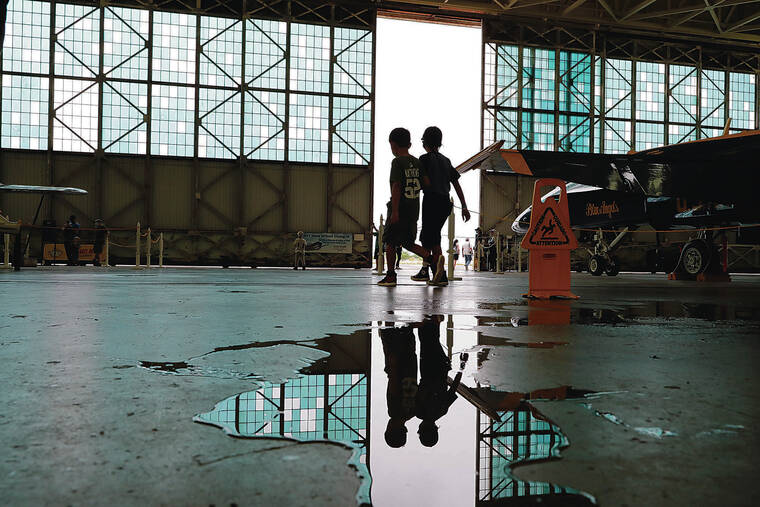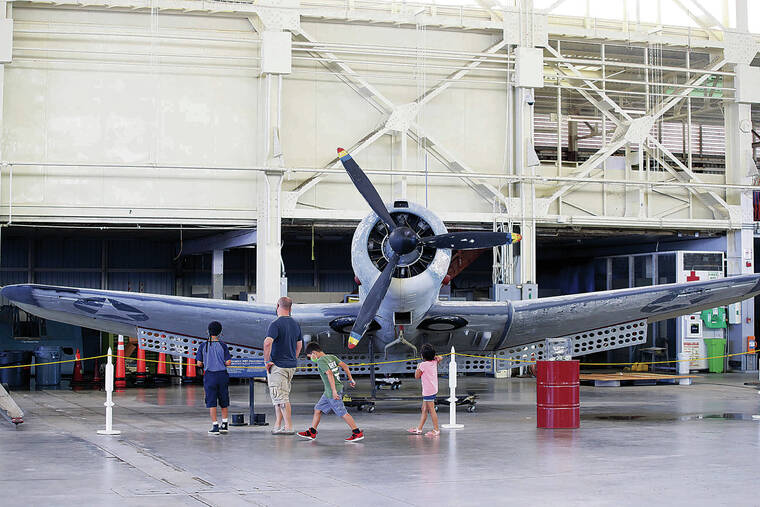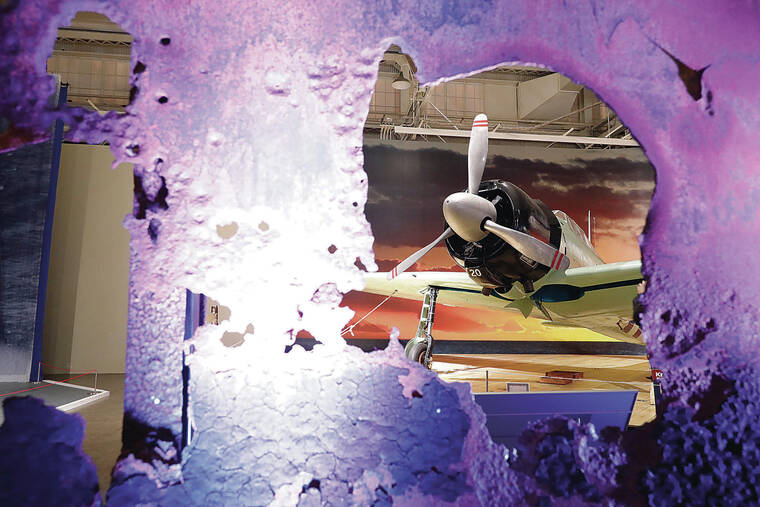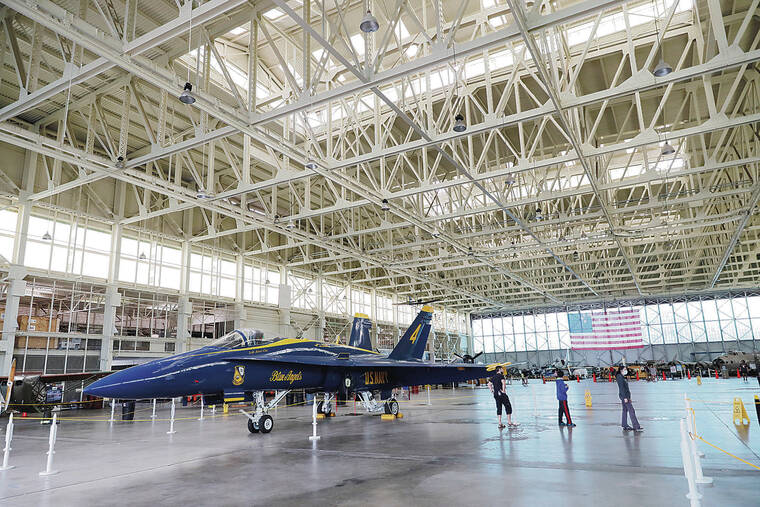Pearl Harbor Aviation Museum repairing roof of historical structure that played a role in World War II

JAMM AQUINO / JAQUINO@STARADVERTISER.COM
Visitors to Hangar 79 at the Pearl Harbor Aviation Museum are reflected in puddles of rainwater. The hangar is temporarily closed for renovation.

JAMM AQUINO / JAQUINO@STARADVERTISER.COM
Bullet holes from the attack on Pearl Harbor on Dec. 7, 1941, are seen in the hangar glass at the Pearl Harbor Aviation Museum.

JAMM AQUINO / JAQUINO@STARADVERTISER.COM
People walk inside Hangar 79 at the Pearl Harbor Aviation Museum.

JAMM AQUINO / JAQUINO@STARADVERTISER.COM
A Japanese Zero aircraft is framed through the hull of the USS Arizona inside the Pearl Harbor Aviation Museum.

JAMM AQUINO / JAQUINO@STARADVERTISER.COM
A Blue Angels F/A-18 Hornet is seen inside Hangar 79 at the Pearl Harbor Aviation Museum.





On a rainy day, Hangar 79 on Pearl Harbor’s Ford Island would seem to be the best way to bring the outdoors indoors, its 86,000 square feet creating an airy, expansive feel underneath its huge roof.
The structure, now part of the Pearl Harbor Aviation Museum, shares history with that sense of spaciousness as well, as one of the few buildings left standing from the attack on Pearl Harbor on Dec. 7, 1941.
“This is the only (aviation) museum on an American World War II battlefield,” said Elissa Lines, executive director of the museum.
But the hangar is also showing its age. While history is embodied by the bullet holes on the light-blue windows, its ceiling is deteriorating. Skylights in the ceiling have cracked and broken, with chunks of the translucent material sometimes flaking off and falling to the floor some 60 feet below. During the recent storms, staff had to place plastic garbage cans in various places inside the hangar to catch rainwater falling from the rafters. Puddles had formed in about a dozen locations.
So the museum, which opened in 2006 and attracts more than 1,000 visitors a day during the high tourist season, has launched a “Raise the Roof” campaign, temporarily closing Hangar 79 as part of a multiphase rehabilitation project that could take up to a year or more. It hopes to raise a total of $4 million for the entire project, which would involve not only fixing the roof but creating new display spaces and exhibits within the hangar.
Almost half of that funding is already in the pipeline, thanks to donation of up to $1 million from a single donor, who has offered it as a challenge grant to be matched within one year. The museum has already raised almost $700,000 toward that goal.
Don't miss out on what's happening!
Stay in touch with breaking news, as it happens, conveniently in your email inbox. It's FREE!
During a recent visit to the museum, only a few aircraft were on display in the hangar, including a Boeing F/A-18C Hornet flown by the Blue Angels and a Grumman TBM Avenger, “the kind that President George Bush flew and jumped out of,” Lines said. Up to 30 aircraft could be exhibited inside if the roof didn’t leak, she said.
“As soon as it starts raining, you get water coming into the hangar, which creates an unsafe situation,” Lines said. “What you have now are airplanes on display, with maybe a placard, but because the hangar is exposed to the elements, there’s no exhibitry in there.”
Built at a cost of about $1 million after Congress enacted legislation in 1939 beefing up the nation’s strategic military bases, Hangar 79 was considered a “medium- to large-sized” Navy hangar at the time of its construction, said Rod Bengston, director of exhibits, restoration and curatorial services for the museum. The Navy was able to build it quickly, in part because much of the material came from a nearby hangar that was taken down.
In its heyday, Hangar 79 was used primarily for aircraft repairs and assembly and mounting of weapons systems on the planes. Another section of the hangar, a second-floor mezzanine level, was used for the maintenance of parachutes.
“It was a complete shop,” Bengston said.
The hangar was equipped with a number of labor-saving devices, like huge, floor-to-ceiling sliding doors that operated so smoothly that a single person could operate them. Over time, the mechanism has rusted and deteriorated, so “now we use a tug to open and close them because we don’t want to hurt anybody,” Bengston said.
Similarly, a single person could move aircraft using a lifting system mounted from the ceiling beams. The system, which is still functioning, was all joined together on tracks, so that airplanes could be moved anywhere inside the hangar.
“A PBY (an amphibious aircraft with a wingspan of about 103 feet) could be brought straight through this building,” Bengston said.
Other features are more personal, such as the scrawled signatures of some Navy personnel in the cement floor.
The roof was built to accommodate Hawaii’s climate. While it is mostly flat, the roof has three smaller structures, called “monitors,” protruding upward into the air. Their design allows breezes to flow freely through them, carrying away hot air from inside the hangar, but keeping the rain out.
With the building itself oriented to take advantage of northeast tradewinds, it provided a comfortable environment for the mechanics and other personnel working inside, especially when the huge doors were open to create a draft.
“It could get very hot in here if the Navy had not designed it with the ability to vent itself,” Bengston said.
The hangar is “a stunning example of the 1940s presence in the Pacific of the Navy, and it is a survivor of the attack, and it just goes to show what an amazing construction it was,” Bengston said. “And it stayed in use for much of the last 80 years.”
With much of the funding in hand, the museum decided to close Hangar 79 for the time being to begin work on the monitors. Lines, the museum’s executive director, said visitors can expect it to open and close periodically as the project continues over the next year.
Eventually, Hangar 79 will be transformed into a multipurpose exhibition space, similar to Hanger 37, a 25,000-square-foot structure that is currently the museum’s current main display space. Plans call for Hangar 79 to house air-conditioned bays for displays and classrooms, and the second-story mezzanine, which has been closed to visitors, will have lookouts for viewing aircraft from above. There will be plenty of room for the museum’s ever-growing collection of artifacts.
“We get donations all the time,” Lines said. “They’re all in storage.”
For Lines, the rehabilitation of Hangar 79 will only enhance the sense of history that is embodied in the museum.
“It is the only place in the world where you can stand and view where the war began in Pearl Harbor and where it ended on the deck of the Battleship Missouri,” she said. “So I think our hangars share that story in a very profound way.”
Visitors also should be on the lookout for the opening of the museum’s control tower, which is scheduled for sometime in the next three months. Standing 158 feet above ground, the tower was not yet in operation in 1941, but got its own claim to fame after it appeared in the 1970 film “Tora! Tora! Tora!” about the Pearl Harbor attack.
“Everyone comes here wanting to see the control tower,” Lines said.
Lines said she expects only about 100 people a day will be able to visit the tower, which was built for a maximum of 12 air traffic controllers at a time. The view it offers will be a highlight of the tour.
“We’re just waiting to complete the final inspection with the Navy, and then we’ll be able to bring people up that facility, which will provide people with an unsurpassed view of all of Pearl Harbor,” she said.
—
Help Raise the Roof
To donate to the Pearl Harbor Aviation Museum’s rehabilitation project, visit pearlharboraviationmuseum.org/raise-the-roof Opens in a new tab.



